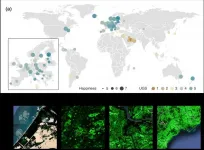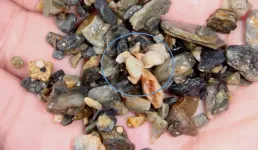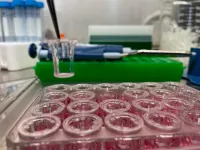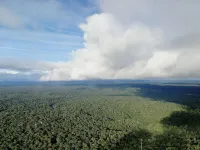Urban green space brings happiness when money can't buy it anymore
High-resolution satellite imagery data unveiled a global correlation between urban green space and happiness in 60 countries
2021-06-22
(Press-News.org) Urban green spaces, such as parks, backyards, riverbanks, and urban farmlands, are thought to contribute to citizen happiness by promoting physical and mental health. While a number of previous studies have reported the mental bene?ts of green space, most had been conducted in the affluent parts of the world like the United States and Europe, and only a few involved a multi-country setting.
Lack of data had been the main limitation in carrying out these studies because there is no global medical dataset that can provide reliable and standardized mental health surveys from different countries. Another challenge involves a systematic method to measure the amount of green space across countries. Various methods of measuring green space - questionnaires, qualitative interviews, satellite images, Google Street View images, and even smartphone technology still rely on individual-level measurements and hence are not scalable to the global level. These challenges left the question of the association between the positive effect of green space on mental health open and unanswered for many countries with different socioeconomic conditions.
Led by the Chief Investigator and an Associate Professor CHA Meeyoung at the Institute for Basic Science (IBS) and Korea Advanced Institute of Science and Technology (KAIST) in Daejeon, South Korea, an international collaboration of researchers from POSTECH, Max Planck Institute, New Jersey Institute of Technology, and the National University of Singapore set out to tackle the issue. The new study which was published in the journal EPJ Data Science identified the global correlation between urban green space and happiness in 60 countries using a satellite imagery dataset.
Using the Sentinel-2 satellite imagery dataset, the team measured each country's urban green space score as the total vegetation index per population in the most populated cities. A total of ninety cities in sixty countries were chosen to represent at least 10% of the population in the studied countries. For a clear view, only the satellite imagery data from summertime were used for analysis, which is June to September for the Northern Hemisphere and December to February for the Southern Hemisphere. The happiness score was taken from the World Happiness Report published by the United Nations.
The team found a significant positive correlation between urban green space and happiness across all countries. Urban green space adds increased happiness compared to the baseline happiness value determined by the wealth of a nation. This relationship was robust for other socioeconomic conditions, including life expectancy, health expenditure, unemployment, gender inequality, and education.
The team also examined whether this association was uniform across all countries. Happiness in the top 30 wealthiest countries (i.e., GDP per capita of 38,000 USD or above) is strongly affected by the amount of urban green space, whereas the GDP per capita is a more critical factor of happiness in the bottom 30 countries. This finding corroborates the conventional wisdom that economic prosperity is crucial for happiness up to a certain level, after which urban green space is a better indicator of happiness. This finding coincides with a concept known as the Easterlin paradox, which tells us that increases in happiness through wealth reach a saturation point, after which the factors that improve happiness are unknown.
The team also identified a direct positive relationship between social support to urban green space. This indicates that the variable of social support can serve as a mediator between green space and happiness. This finding underlines the importance of maintaining urban green space as a place for social cohesion in support of people's happiness.
The authors point out their work has several policy-level implications. First, public green space should be made accessible to urban dwellers to enhance social support. If public safety in urban parks is not guaranteed, its positive role in social support and happiness may diminish. Also, the meaning of public safety may change; for example, ensuring biological safety will be a priority in keeping urban parks accessible during the COVID-19 pandemic.
Second, urban planning for public green space is needed for both developed and developing countries. As it is challenging or nearly impossible to secure land for green space after the area is developed, urban planning for parks and green space should be considered in developing economies where new cities and suburban areas are rapidly expanding.
Third, recent climate changes can present substantial difficulty in sustaining urban green space. Extreme events such as wild?res, ?oods, droughts, and cold waves could endanger urban forests while global warming could conversely accelerate tree growth in cities due to the urban heat island effect. Thus, more attention must be paid to predict climate changes and discovering their impact on the maintenance of urban green space.
The authors also highlight the increasing demand for data-driven policy-making for citizens. "Big data from satellite imagery can provide great opportunities to answer a variety of social issues. Our method can be used to quantify blue space at shores, and we may further study the relationship between blue space and happiness", says Dr. Cha.
INFORMATION:
[Attachments] See images for this press release:

ELSE PRESS RELEASES FROM THIS DATE:
2021-06-22
Solar cells, which convert sunlight to electricity, have long been part of the global vision for renewable energy. Although individual cells are very small, when upscaled to modules, they can be used to charge batteries and power lights. If laid side-by-side, they could, one day, be the primary energy source for buildings. But the solar cells currently on the market utilize silicon, which makes them expensive to fabricate when compared to more traditional power sources.
That's where another, relatively new-to-science, material comes in - metal halide perovskite. When nestled at the center of a solar cell, this crystalline structure also ...
2021-06-22
A team of researchers from the National University of Singapore (NUS) and the University of the Ryukyus has recently identified and described a bizarre new genus and species of xanthid crab found in Okinawa Island, Ryukyu Islands, Japan. Named Mabui calculus, it is unique among the 7,800 species of known crabs in having strongly asymmetrical male and female reproductive structures!
"Male crabs have a pair of reproductive parts called gonopods while females have a pair of vulvae. All crabs mate in the 'missionary position', so the gonopods pump sperm into females for internal fertilisation of the eggs. This was the accepted orthodoxy until our discovery - a small Japanese crab has evolved to do this very differently!" explained Professor Peter Ng, a world-leading expert in ...
2021-06-22
Recent studies show that, in the future, the mercury concentration of fish in Finnish Lapland can shift closer to the level found in lakes located below the Arctic Circle. According to researchers, mercury content should be increasingly carefully investigated and monitored in fish and food webs, as the climate and land use change.
Mercury is a heavy metal found in nature. Methylmercury, a particularly toxic form of the metal, accumulates in fish and is biomagnified in food webs. Humans are exposed to methylmercury especially through fish-based diets.
Researchers investigated the joint effects of the climate and land ...
2021-06-22
COLUMBUS, Ohio - Scientists are pursuing a new strategy in the protracted fight against the SARS-CoV-2 virus by engineering nanobodies that can neutralize virus variants in two different ways.
In lab studies, researchers identified two groups of molecules that were effective against virus variants. Using different mechanisms, nanobodies in each group bypassed mutations and disabled the virus's ability to bind to the receptor that lets it enter host cells.
Though vaccination is enabling the resumption of some pre-pandemic activities in parts of the world, ...
2021-06-22
MISSOULA - The map of Montana Kayla Irish pulls up is peppered with red circles, each cluster providing details behind one of today's timely topics - childhood vaccination.
The project, led by Dr. Sophia Newcomer in the University of Montana's Center for Population Health Research, is the first spatial scan analysis to identify hotspots of undervaccinated children across Montana and evaluate whether they are due to social or geographic barriers.
CPHR is funded through the National Institutes of Health, and the analysis is part of a collaborative ...
2021-06-22
Irvine, Calif., June 21, 2021 -- Cancer immunotherapy involving drugs that inhibit CTLA-4 also activates an unwanted response that may self-limit its efficacy in fighting tumors, according to a new study led by Francesco Marangoni, Ph.D., assistant professor of physiology & biophysics and member of the Institute for Immunology at the University of California, Irvine. Study results are published online in the journal Cell.
Using a person's own immune system - immunotherapy - to treat cancer may also stimulate T regulatory cells, which are essential for preventing autoimmunity, in which the body attacks healthy cells and tissue, but limit tumor control. Some anticancer drugs of the checkpoint inhibitor family block the molecule CTLA-4 and activate ...
2021-06-22
Every year in Canada, six trillion litres of municipal wastewater are partially treated and released into the environment, while another 150 billion litres of untreated sewage are discharged straight into pristine surface waters.
Now researchers have found a way to stem that flow: by filtering the waste through the roots of willow trees. Experimenting with a plantation in Quebec, the scientists estimate that over 30 million litres of primary wastewater per hectare can be treated using 'bio-refinery' annually.
Their results were published June 14 in the journal ...
2021-06-22
[Brooklyn, New York] - [June 21, 2021] - Applied Biological Laboratories (Applied Bio), a biopharmaceutical company focused on the respiratory disease market, announced that its study published online in Immunology, Inflammation and Disease was able to determine the mechanism behind respiratory inflammation and treat it effectively with Biovanta(TM), a 100% naturally derived, over-the-counter (OTC) drug for cold, cough and sore throat.
The study results also showed that almost all of the leading OTC products on the market can damage the upper respiratory cells and may prolong illness. This research study and its findings represent one of the first major breakthroughs in decades for the cold and flu market.
The study, titled ...
2021-06-22
UNIVERSITY PARK, Pa. -- Clickbait headlines might not be as enticing to readers as once thought, according to a team of researchers. They added that artificial intelligence -- AI -- may also come up short when it comes to correctly determining whether a headline is clickbait.
In a series of studies, the researchers found that clickbait -- headlines that often rely on linguistic gimmicks to tempt readers to read further -- often did not perform any better and, in some cases, performed worse than traditional headlines.
Because fake news is a concern on social media, researchers have explored using AI to systematically identify and block clickbait. However, the studies also suggest ...
2021-06-22
Amazon rain forests could be at far higher risk of extreme drought than previously thought, according to new research.
An international study, led by the University of Leeds, warns that huge areas in the eastern part of the Amazon face severe drying by the end of the century if action is not taken to curb carbon emissions.
As a result, large amounts of carbon dioxide would be released from the forest into the atmosphere,
adding to the greenhouse gas effect and driving further climate change.
The increased dryness during the Amazon dry season would further threaten the viability of large parts of the rainforest, as trees are already water stressed and there is greater risk of forest fires.
The predicted droughts could also have far-reaching consequences ...
LAST 30 PRESS RELEASES:
[Press-News.org] Urban green space brings happiness when money can't buy it anymore
High-resolution satellite imagery data unveiled a global correlation between urban green space and happiness in 60 countries





